

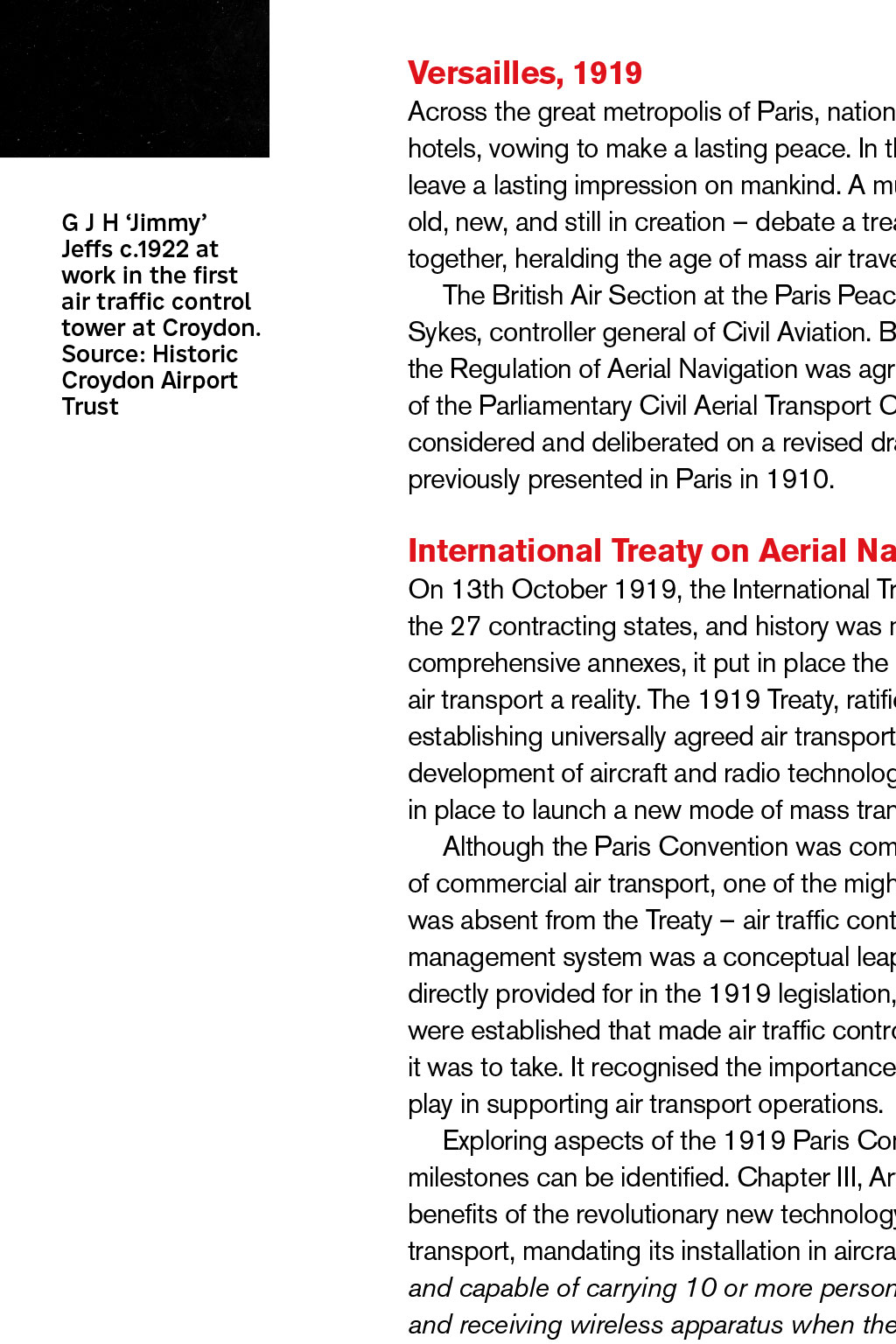
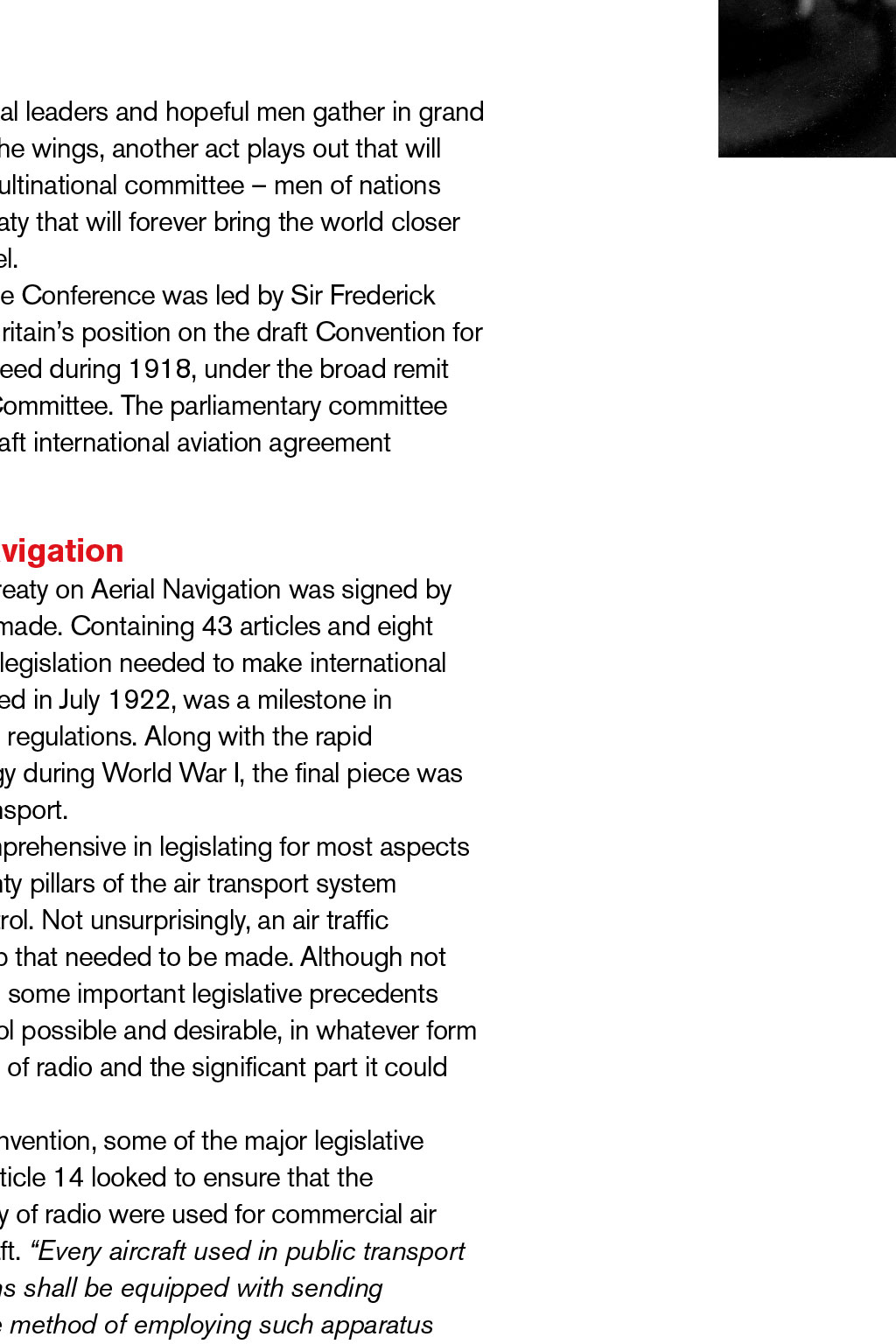
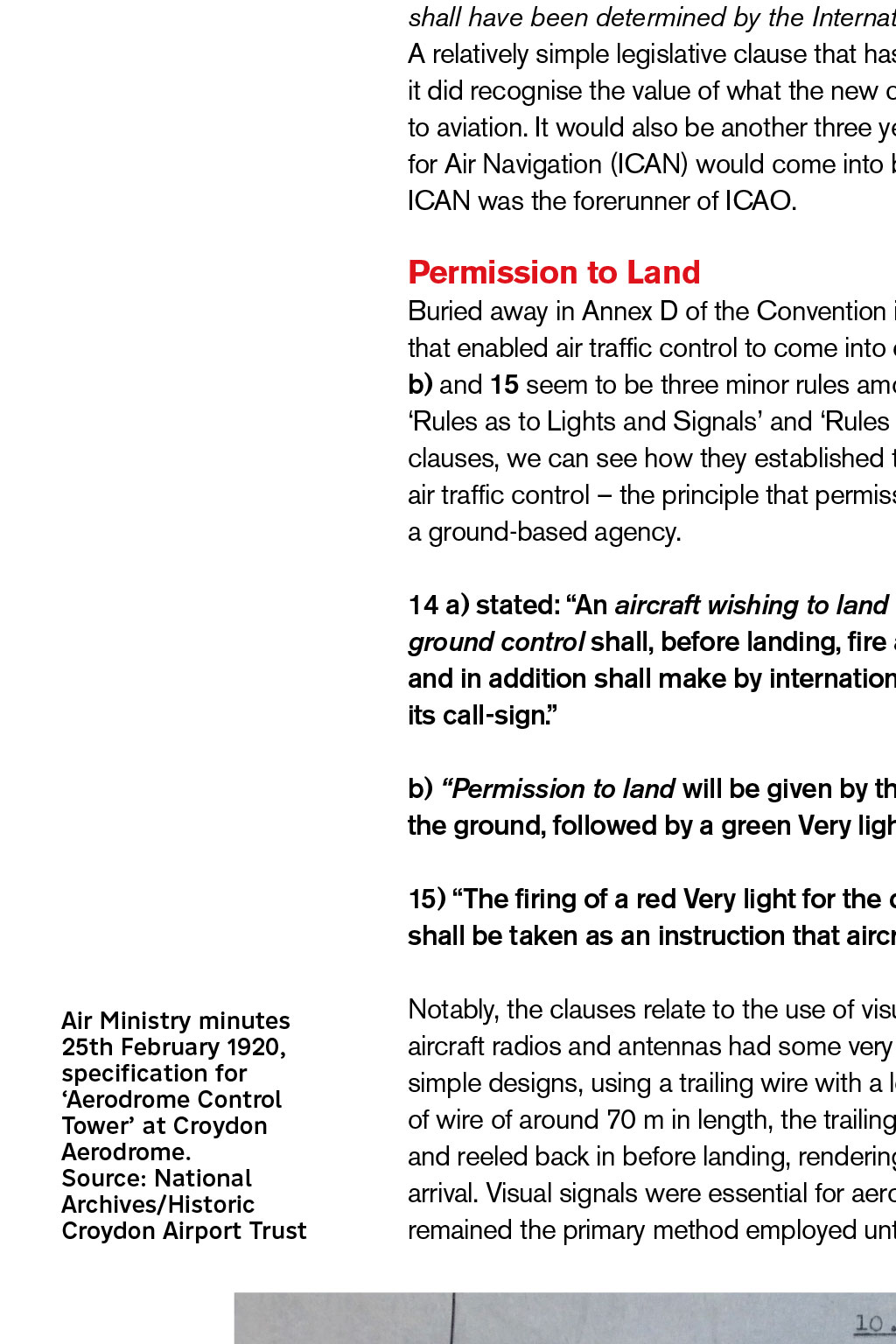
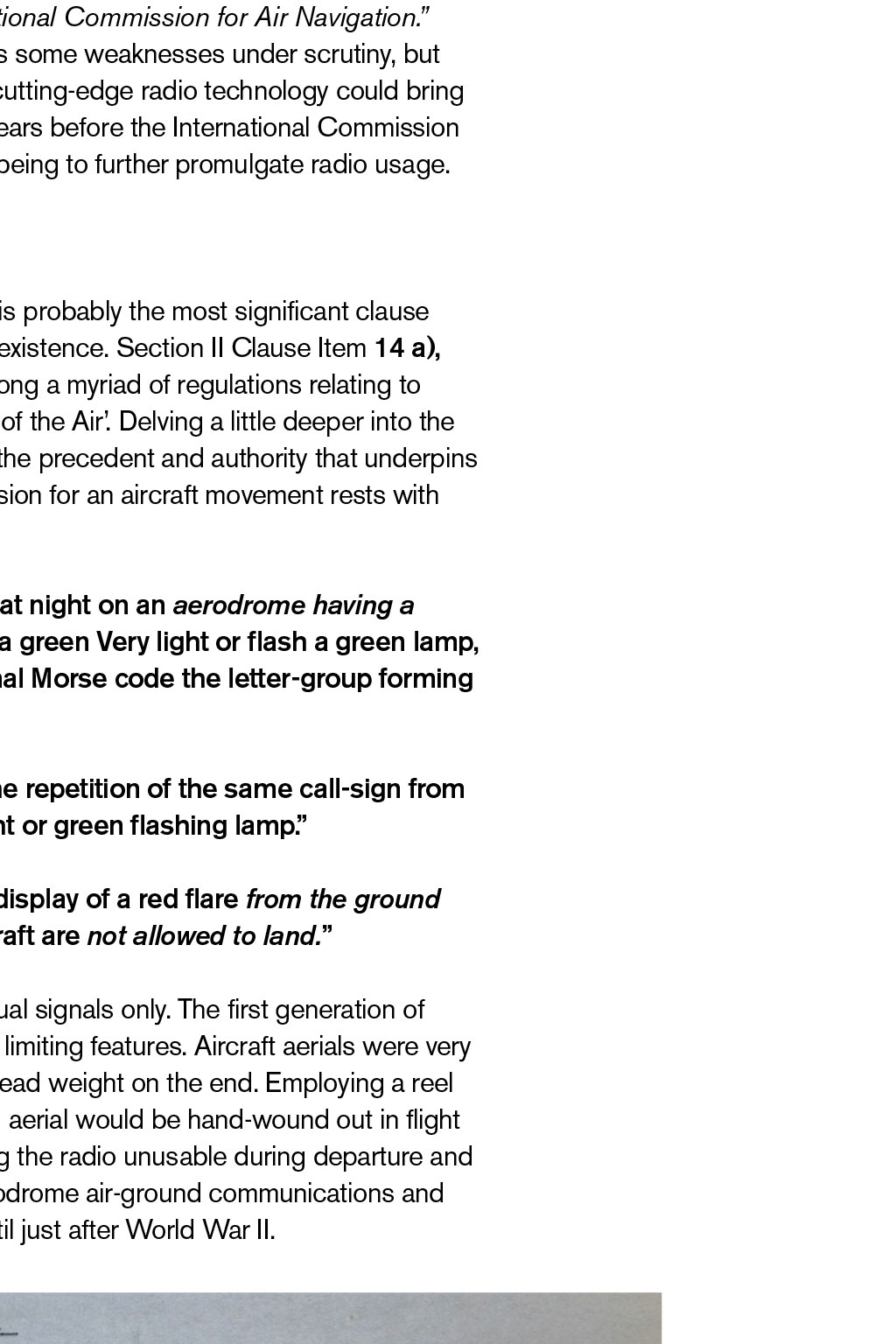
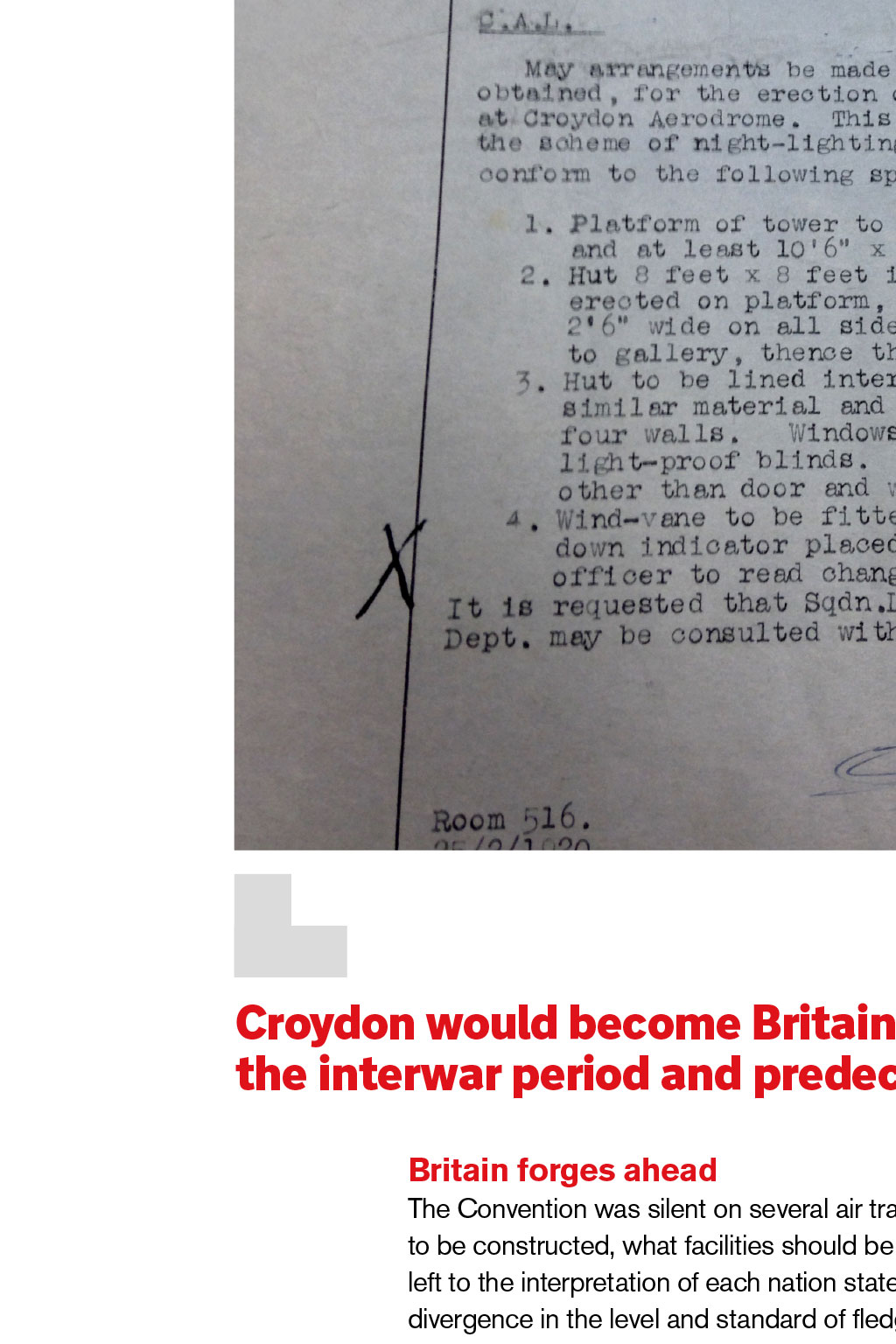
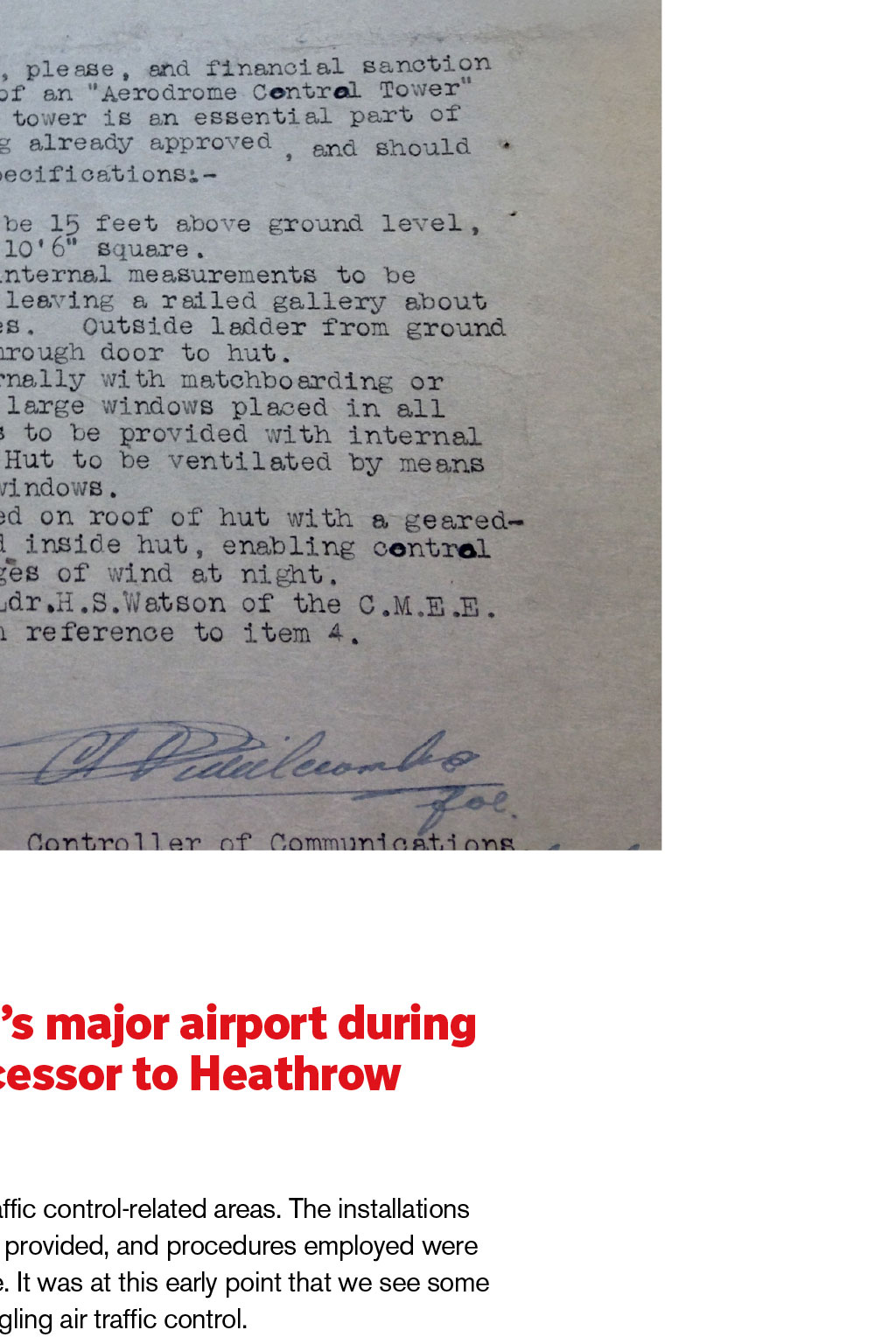
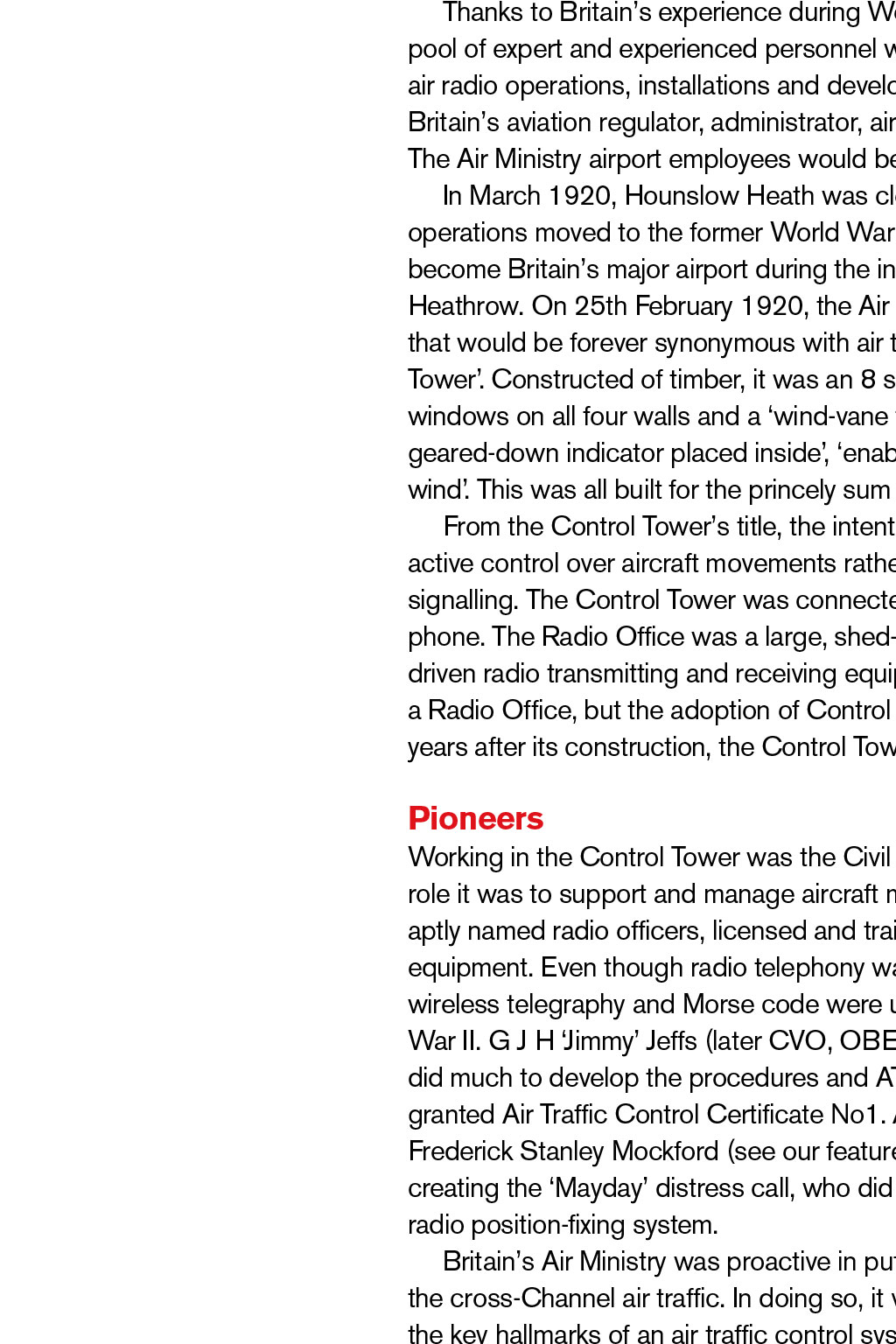
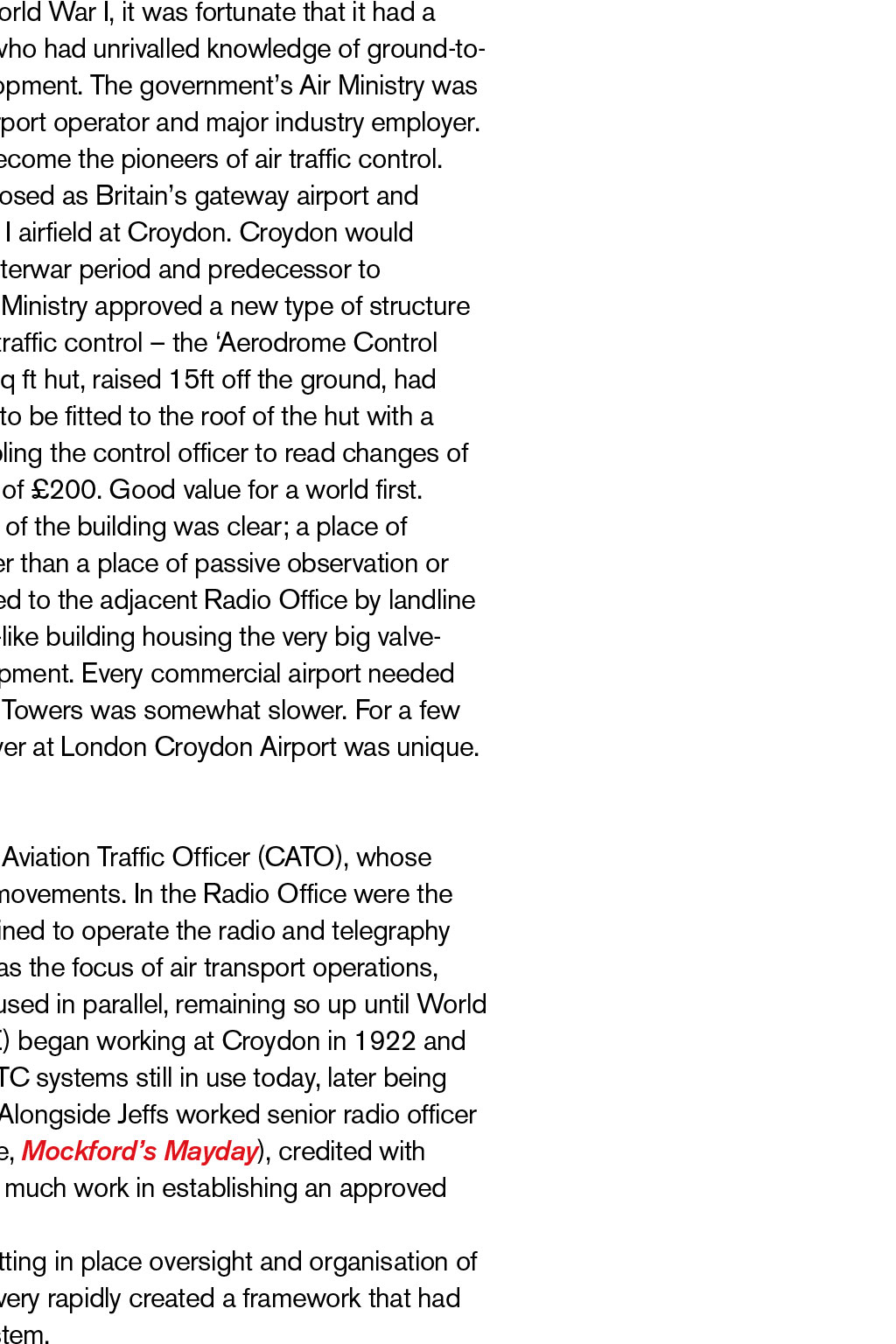
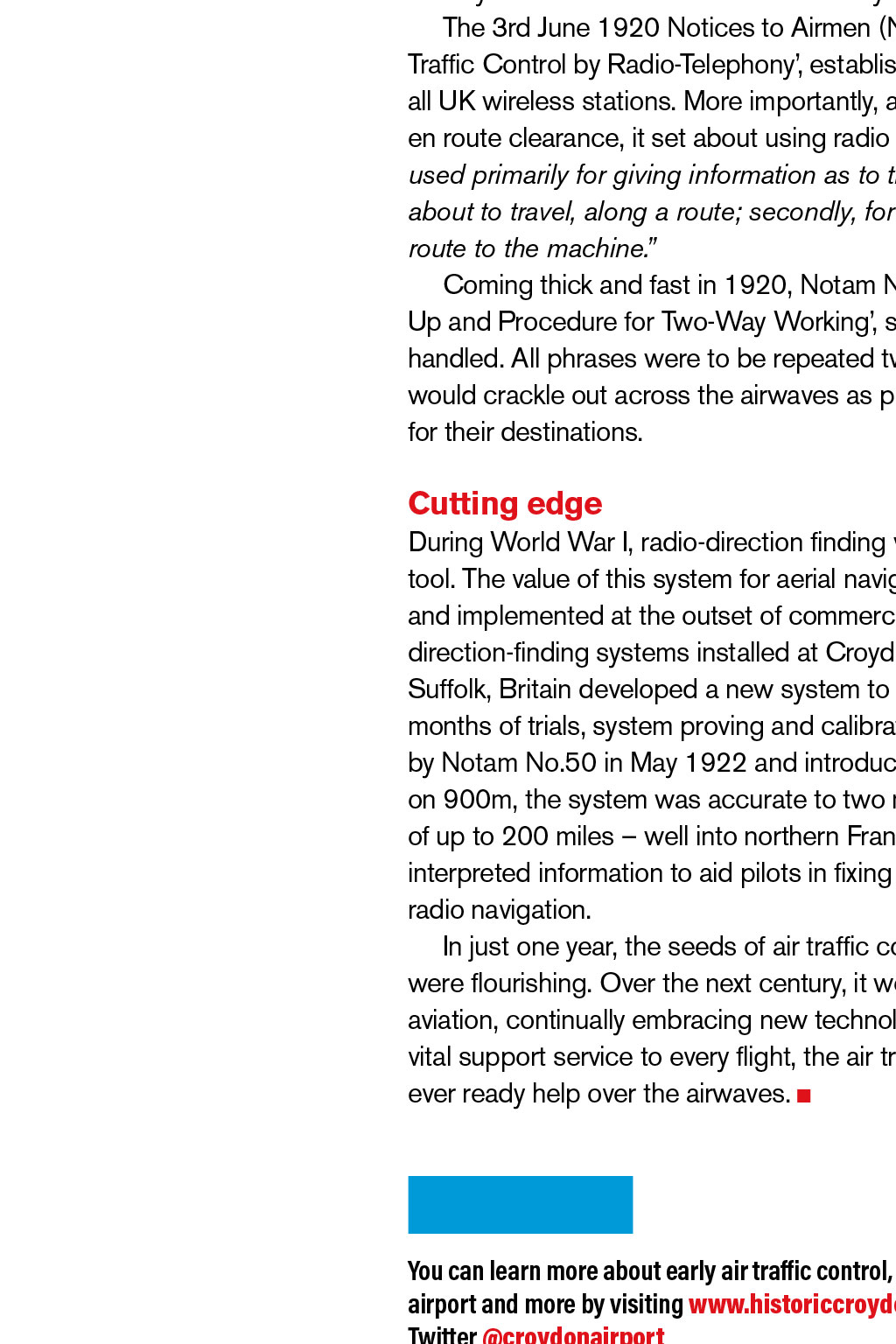
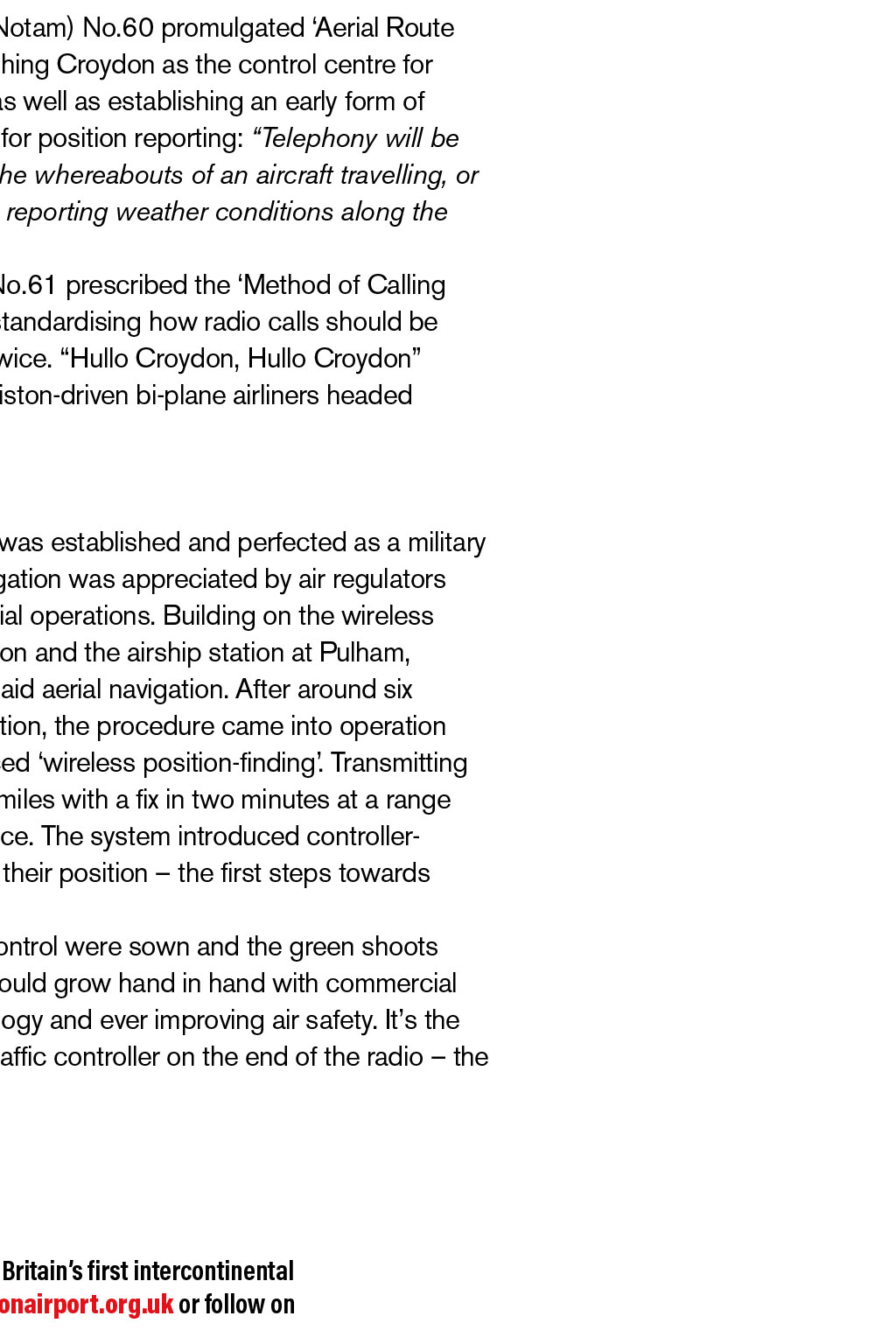
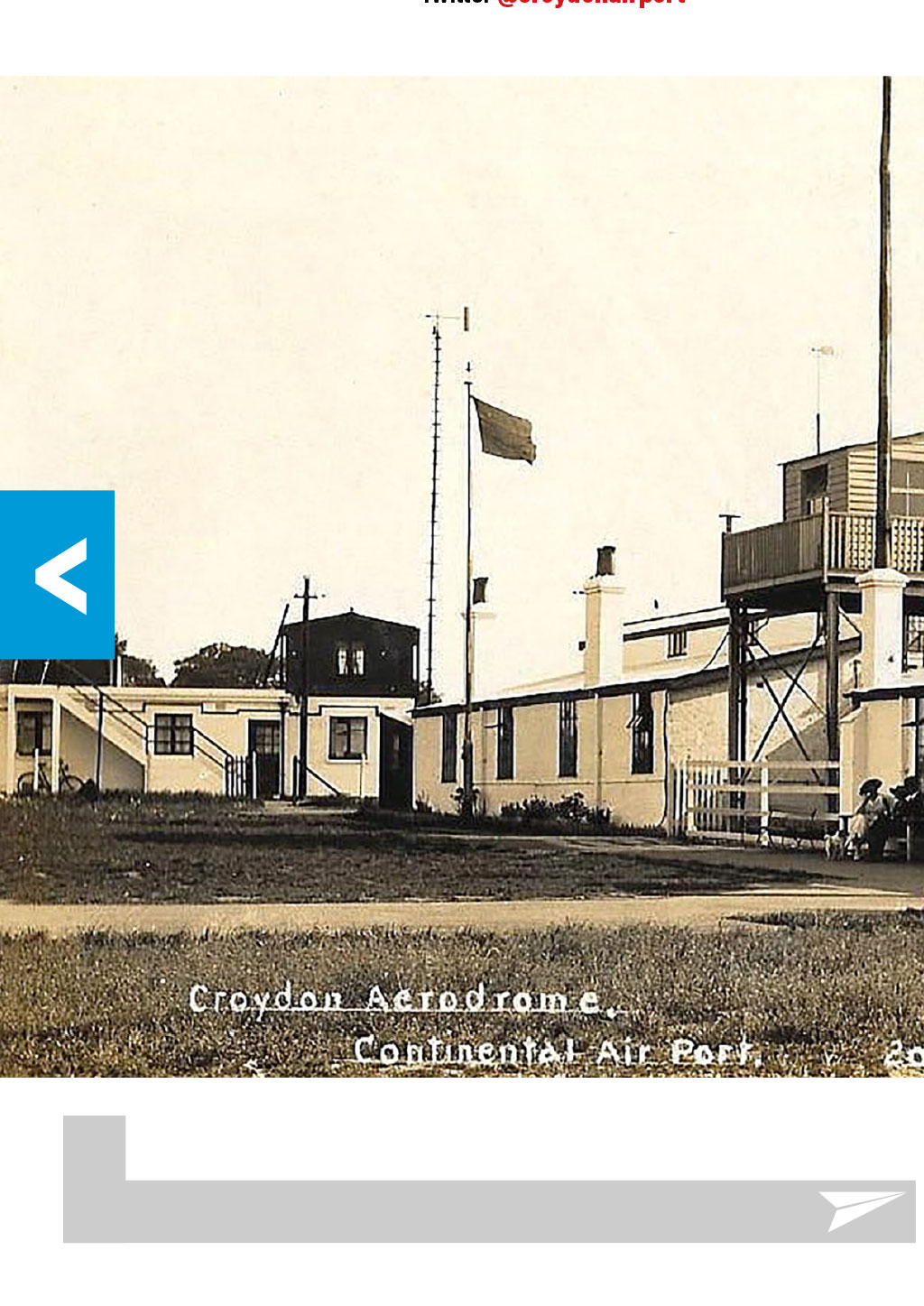
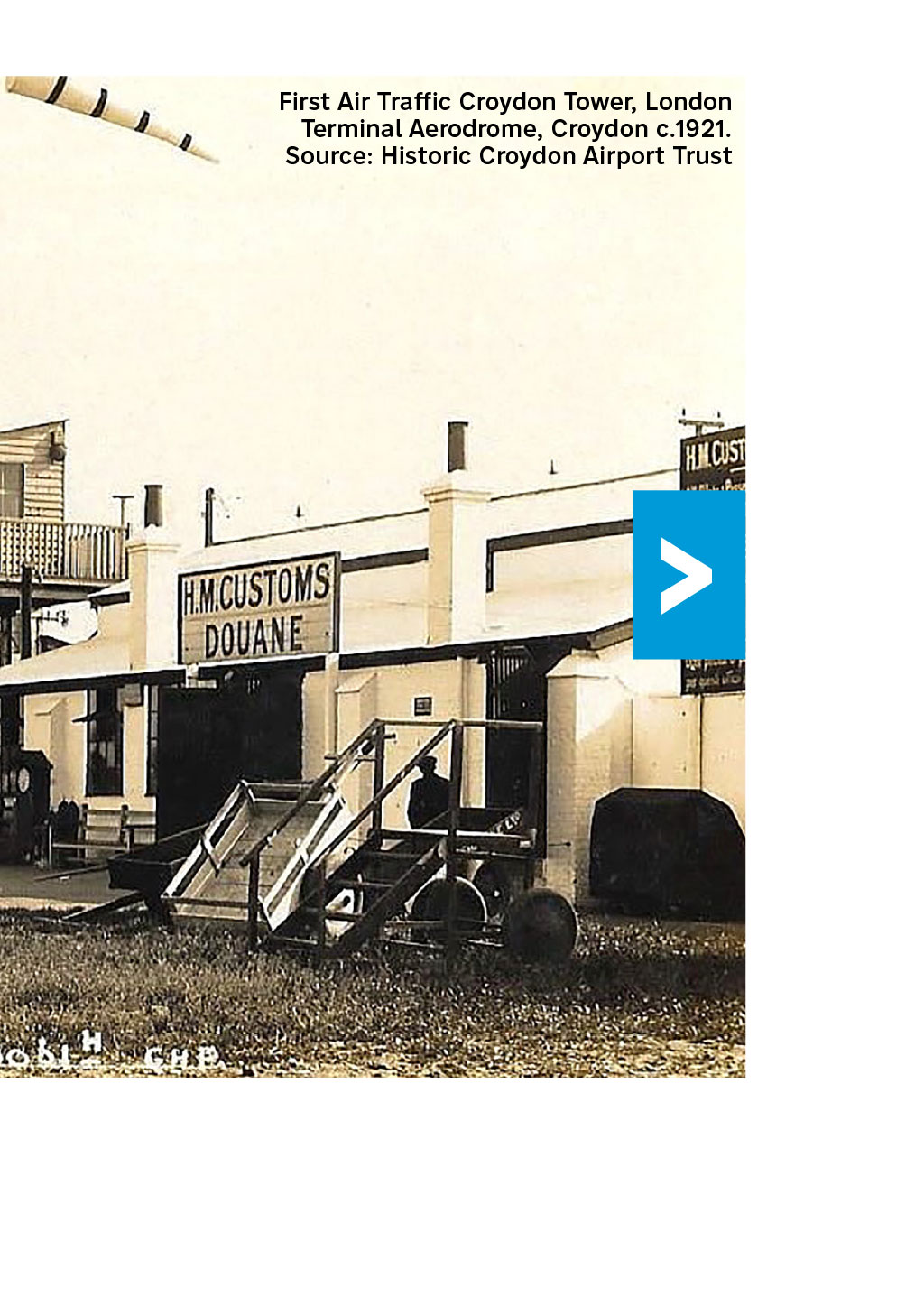















TECH LOG The genesis of Air Traffic Control How ATC came to be By Captain Ian Walker, Chair, Historic Croydon Airport Trust Versailles, 1919 G J H Jimmy Jeffs c.1922 at work in the first air traffic control tower at Croydon. Source: Historic Croydon Airport Trust Across the great metropolis of Paris, national leaders and hopeful men gather in grand hotels, vowing to make a lasting peace. In the wings, another act plays out that will leave a lasting impression on mankind. A multinational committee men of nations old, new, and still in creation debate a treaty that will forever bring the world closer together, heralding the age of mass air travel. The British Air Section at the Paris Peace Conference was led by Sir Frederick Sykes, controller general of Civil Aviation. Britains position on the draft Convention for the Regulation of Aerial Navigation was agreed during 1918, under the broad remit of the Parliamentary Civil Aerial Transport Committee. The parliamentary committee considered and deliberated on a revised draft international aviation agreement previously presented in Paris in 1910. International Treaty on Aerial Navigation On 13th October 1919, the International Treaty on Aerial Navigation was signed by the 27 contracting states, and history was made. Containing 43 articles and eight comprehensive annexes, it put in place the legislation needed to make international air transport a reality. The 1919 Treaty, ratified in July 1922, was a milestone in establishing universally agreed air transport regulations. Along with the rapid development of aircraft and radio technology during World War I, the final piece was in place to launch a new mode of mass transport. Although the Paris Convention was comprehensive in legislating for most aspects of commercial air transport, one of the mighty pillars of the air transport system was absent from the Treaty air traffic control. Not unsurprisingly, an air traffic management system was a conceptual leap that needed to be made. Although not directly provided for in the 1919 legislation, some important legislative precedents were established that made air traffic control possible and desirable, in whatever form it was to take. It recognised the importance of radio and the significant part it could play in supporting air transport operations. Exploring aspects of the 1919 Paris Convention, some of the major legislative milestones can be identified. Chapter III, Article 14 looked to ensure that the benefits of the revolutionary new technology of radio were used for commercial air transport, mandating its installation in aircraft. Every aircraft used in public transport and capable of carrying 10 or more persons shall be equipped with sending and receiving wireless apparatus when the method of employing such apparatus shall have been determined by the International Commission for Air Navigation. A relatively simple legislative clause that has some weaknesses under scrutiny, but it did recognise the value of what the new cutting-edge radio technology could bring to aviation. It would also be another three years before the International Commission for Air Navigation (ICAN) would come into being to further promulgate radio usage. ICAN was the forerunner of ICAO. Permission to Land Buried away in Annex D of the Convention is probably the most significant clause that enabled air traffic control to come into existence. Section II Clause Item 14 a), b) and 15 seem to be three minor rules among a myriad of regulations relating to Rules as to Lights and Signals and Rules of the Air. Delving a little deeper into the clauses, we can see how they established the precedent and authority that underpins air traffic control the principle that permission for an aircraft movement rests with a ground-based agency. 14 a) stated: An aircraft wishing to land at night on an aerodrome having a ground control shall, before landing, fire a green Very light or flash a green lamp, and in addition shall make by international Morse code the letter-group forming its call-sign. b) Permission to land will be given by the repetition of the same call-sign from the ground, followed by a green Very light or green flashing lamp. 15) The firing of a red Very light for the display of a red flare from the ground shall be taken as an instruction that aircraft are not allowed to land. Air Ministry minutes 25th February 1920, specification for Aerodrome Control Tower at Croydon Aerodrome. Source: National Archives/Historic Croydon Airport Trust Notably, the clauses relate to the use of visual signals only. The first generation of aircraft radios and antennas had some very limiting features. Aircraft aerials were very simple designs, using a trailing wire with a lead weight on the end. Employing a reel of wire of around 70 m in length, the trailing aerial would be hand-wound out in flight and reeled back in before landing, rendering the radio unusable during departure and arrival. Visual signals were essential for aerodrome air-ground communications and remained the primary method employed until just after World War II. Croydon would become Britains major airport during the interwar period and predecessor to Heathrow Britain forges ahead The Convention was silent on several air traffic control-related areas. The installations to be constructed, what facilities should be provided, and procedures employed were left to the interpretation of each nation state. It was at this early point that we see some divergence in the level and standard of fledgling air traffic control. Thanks to Britains experience during World War I, it was fortunate that it had a pool of expert and experienced personnel who had unrivalled knowledge of ground-toair radio operations, installations and development. The governments Air Ministry was Britains aviation regulator, administrator, airport operator and major industry employer. The Air Ministry airport employees would become the pioneers of air traffic control. In March 1920, Hounslow Heath was closed as Britains gateway airport and operations moved to the former World War I airfield at Croydon. Croydon would become Britains major airport during the interwar period and predecessor to Heathrow. On 25th February 1920, the Air Ministry approved a new type of structure that would be forever synonymous with air traffic control the Aerodrome Control Tower. Constructed of timber, it was an 8 sq ft hut, raised 15ft off the ground, had windows on all four walls and a wind-vane to be fitted to the roof of the hut with a geared-down indicator placed inside, enabling the control officer to read changes of wind. This was all built for the princely sum of 200. Good value for a world first. From the Control Towers title, the intent of the building was clear; a place of active control over aircraft movements rather than a place of passive observation or signalling. The Control Tower was connected to the adjacent Radio Office by landline phone. The Radio Office was a large, shed-like building housing the very big valvedriven radio transmitting and receiving equipment. Every commercial airport needed a Radio Office, but the adoption of Control Towers was somewhat slower. For a few years after its construction, the Control Tower at London Croydon Airport was unique. Pioneers Working in the Control Tower was the Civil Aviation Traffic Officer (CATO), whose role it was to support and manage aircraft movements. In the Radio Office were the aptly named radio officers, licensed and trained to operate the radio and telegraphy equipment. Even though radio telephony was the focus of air transport operations, wireless telegraphy and Morse code were used in parallel, remaining so up until World War II. G J H Jimmy Jeffs (later CVO, OBE) began working at Croydon in 1922 and did much to develop the procedures and ATC systems still in use today, later being granted Air Traffic Control Certificate No1. Alongside Jeffs worked senior radio officer Frederick Stanley Mockford (see our feature, Mockfords Mayday), credited with creating the Mayday distress call, who did much work in establishing an approved radio position-fixing system. Britains Air Ministry was proactive in putting in place oversight and organisation of the cross-Channel air traffic. In doing so, it very rapidly created a framework that had the key hallmarks of an air traffic control system. The 3rd June 1920 Notices to Airmen (Notam) No.60 promulgated Aerial Route Traffic Control by Radio-Telephony, establishing Croydon as the control centre for all UK wireless stations. More importantly, as well as establishing an early form of en route clearance, it set about using radio for position reporting: Telephony will be used primarily for giving information as to the whereabouts of an aircraft travelling, or about to travel, along a route; secondly, for reporting weather conditions along the route to the machine. Coming thick and fast in 1920, Notam No.61 prescribed the Method of Calling Up and Procedure for Two-Way Working, standardising how radio calls should be handled. All phrases were to be repeated twice. Hullo Croydon, Hullo Croydon would crackle out across the airwaves as piston-driven bi-plane airliners headed for their destinations. Cutting edge During World War I, radio-direction finding was established and perfected as a military tool. The value of this system for aerial navigation was appreciated by air regulators and implemented at the outset of commercial operations. Building on the wireless direction-finding systems installed at Croydon and the airship station at Pulham, Suffolk, Britain developed a new system to aid aerial navigation. After around six months of trials, system proving and calibration, the procedure came into operation by Notam No.50 in May 1922 and introduced wireless position-finding. Transmitting on 900m, the system was accurate to two miles with a fix in two minutes at a range of up to 200 miles well into northern France. The system introduced controllerinterpreted information to aid pilots in fixing their position the first steps towards radio navigation. In just one year, the seeds of air traffic control were sown and the green shoots were flourishing. Over the next century, it would grow hand in hand with commercial aviation, continually embracing new technology and ever improving air safety. Its the vital support service to every flight, the air traffic controller on the end of the radio the ever ready help over the airwaves. You can learn more about early air traffic control, Britains first intercontinental airport and more by visiting www.historiccroydonairport.org.uk or follow on Twitter @croydonairport First Air Traffic Croydon Tower, London Terminal Aerodrome, Croydon c.1921. Source: Historic Croydon Airport Trust Colourised first Air Traffic Croydon Tower, London Terminal Aerodrome, Croydon c.1921. Source: Historic Croydon Airport Trust/NATS